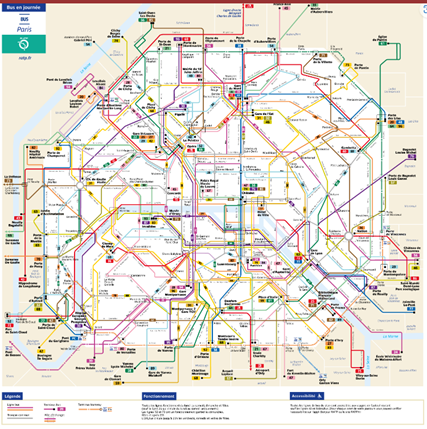
I was lucky enough to take a five-day getaway with my spouse to Paris earlier this year. The weather was chilly but thankfully sunny, and we were able to explore various parts of the city. All our outings, naturally, revolved around food, beverages, and the use of public transportation. During our breaks between wine and cheese tastings, I had a chance to reflect on a few transit and transportation takeaways and experiences from the trip.
Five lines in Paris’ metro system run on rubber tires. This was fascinating to me! Technically I learned about this from Ehab and Charlie at the Foursquare ITP trivia night right before the trip, but it was fun to see in action. I probably would have been too focused on the system map in the station otherwise to have even noticed!
After consulting Wikipedia, I learned that the only places where rubber tire systems exist in the US are at airports, with the exception of Miami’s Metromover. France and Japan seem to have the most rubber tire systems, with other notably large rubber tire systems or lines in Montreal, Mexico City, Santiago, and Cairo. For more fun facts about the pros and cons of rubber tire systems, Wikipedia (the ultimate source, of course) gives a good overview.
None of the historical street-level station entrances I saw had prominent signage about which lines serve the station. This was also surprising to me, because I’m used to going out of my way to avoid transfers. Many of the stations I went to in Paris did not make it easy to do that! I assume this is because either there are historical preservation rules about not altering historical station entrances, or (my preferred explanation) with two- to four-minute headways throughout the system, transfers don’t matter as much to most people. Maybe it’s a combination of both? Tell me if you know!
Whatever the reason, we got used to not even consulting the system map to make sure we were getting on the “right” line to avoid a transfer during our stay in Paris. Instead, we just entered the first station we saw. Eventually, I did notice that the stations with the newer red signs do indicate the line numbers.

I appreciated the variety of colors on the Paris bus map. They made it easier for me to follow the lines throughout the city. I’m a bit embarrassed to admit I did not use the bus while I was there due to the superior travel times of the Metro for getting to my destinations, but it did seem to run efficiently.
Transit and other transportation workers in France were on strike. Parisians were striking due to the government’s attempt to increase the retirement age from 62 to 64. We saw stickers saying “raise wages, not the retirement age” throughout the system. Setting policy opinions aside, I’ll just say that it felt like we got a uniquely French experience at one of the strike-related protest rallies. There was live music and a celebratory atmosphere despite the serious nature of the proposal. And while strikes have affected the public transit system, there were still a variety of ways to get around that didn’t involve driving one’s own car.

It had been several years since I had previously been to Paris, and I was struck by how bike-friendly and bike-oriented all the streets were. Every major road seemed to have a protected and separated bike lane. I would love if the bike network in DC were as extensive as it is in Paris!
It’s always fun to see how transit is done in other countries and think about how we as planners can strive to make our own systems here better. À la prochaine dans un bus, un train ou un vélo!